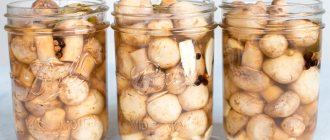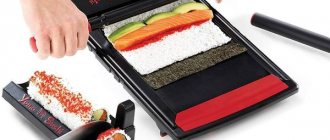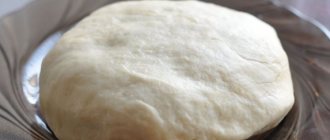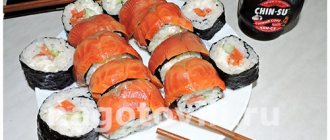Rolls are a very popular dish in Japanese cuisine. More and more Japanese restaurants are opening, but people already want to be able to make rolls without leaving home! And it's possible! Moreover, it is quite an easy task. All ingredients for their preparation are sold in large supermarkets or specialty stores. There they can also advise you on how to prepare certain rolls at home.
Sushi at home: varieties and popularity
Sushi is a traditional, popular Japanese food made from fresh fish and rice. But Philadelphia and California rolls are an American interpretation of traditional Japanese sushi. They have a more delicate taste and are prepared without much effort. The advantage of this dish is the minimum required ingredients.
Japanese sushi can be divided into four types:
- Oshi (pressed sushi). This type of sushi can be called lazy because the preparation process requires minimal effort. The fish, preferably red, is placed at the bottom of a shallow vessel. Place rice on it to the brim of the bowl and bend it to the top. After 1–3 hours, remove the resulting layer. Turn it over so the fish is facing up and cut it into portions.
- Nigiri (compressed sushi). Also from the lazy series. To prepare it with your hands, take the rice and form a compressed small block (the size of a finger), and put a piece of red fish on top. Typically, nigiri is made from two types of fish and served in pairs.
- Chirashi (separate sushi) . They are the most popular in Japan. To prepare, place the rice in small containers, and pile fish and vegetables on top. These are portioned containers with separate sushi.
- Maki (rolls). This is a familiar version that is served in all Japanese restaurants. Rice, vegetables, and all kinds of seafood are wrapped in nori seaweed. Next, the resulting roll is cut into the sushi we already love.
Mini rolls step by step recipe with photos
To prepare any rolls, you will need a bamboo mat, plastic wrap, and nori leaves—thin compressed seaweed. All this can now be easily bought at any hypermarket.
1. Prepare a bamboo mat. It is better if it consists of round sticks, but flat ones are also suitable. We wrap the mat in cellophane, completely and quite tightly. Japanese chefs, of course, don’t do this, but I would recommend it. The rice won’t stick to the board that way, and for hygiene purposes, it won’t hurt.
2. So - like we have mini-rolls, take a sheet of nori and cut it in half, this can be done with a knife or scissors..
mat wrapped in cellophane half a sheet of nori
3. Place the sheet of nori with the rough side up, respectively smooth, on the mat, retreating 1 - 1.5 centimeters from the beginning of the board.
4. With hands dipped in water and lemon, spread the specially prepared rice in a thin layer on a sheet. We distribute the rice in such a way that the top of the nori sheet remains uncovered, about one centimeter, and from the bottom, the same centimeter of rice should protrude beyond the sheet. Let's look at the photo.
5. We compact the rice tightly, remove the excess, and make it beautiful, because we need to get a beautiful final product.
6. We lay out your filling, what you have prepared: a good piece of fish, fresh or pickled cucumber, avocado, of course it’s all cut into pieces. Place the pieces approximately at the intersection of rice and nori, closer to the beginning of the rice.
Now, the wrapping itself is approximately done in 3–4 stages.
Don't forget to wet your fingers in lemon water.
7. We take the mat, our task now is to cover and wrap the filling with the initial layer of rice, which does not lie on the nori. Carefully fold the rice and press it in. (I hope I described it clearly...)
You can unroll the mat and it should look like the photo below; the filling is wrapped and the nori sheet is still left.
8. We looked, everything is fine! Next, wrap the roll, covering the remaining rice.
9. Unroll again, leave a small strip of nori unwrapped, moisten it with water and finally seal the roll tightly.
10. You should get a beautiful sausage. Now you can cut it into portions with a knife. Wet the knife with water.
What did we get? What we got was a neatly rolled mini-roll, standard, which is sold in all sushi bars. As you can see, there is nothing complicated.
If you master and understand the very principle of wrapping, then everything will go on like clockwork. Let's move on in ascending order.
What is needed to make sushi and rolls at home?
Let's list the tools and equipment that you simply cannot do without in the process of making sushi. Required special tools for work:
- A special machine for making rolls.
- If you don’t have a machine, a bamboo makisu mat is ideal. With its help you will twist future sushi.
- A sharp knife that will need to be used to cut the resulting roll.
- Two wooden sticks for eating exotic “snacks”.
Auxiliary tools that you can’t do without:
- A saucepan for cooking rice.
- Cling film is required for “inside out” rolls. If you use nori, then its use is at the request of the hostess.
- Soy sauce bath.
Products for making rolls at home
There are mandatory products, without which sushi is hard to imagine, and auxiliary products (spices, snacks). Let's look at the products without which you won't be able to create rolls in your kitchen.
- Rice . It is necessary to take a special, special variety of rice. Usually, the packaging says “Japanese rice” or “Rice for rolls and sushi”; this is what ensures better adhesion of the ingredients. Today you can find such rice in every large supermarket. If there is still a problem with purchasing special rice, then you can take regular round grain rice. The only difference you will be able to feel if you cook it correctly is the larger grains, which makes the roll a little rougher.
- Vinegar , but not simple. To season the rice, use special vinegar for mitsukan rice. It provides a decent connection between the “grains of rice” into one mass, while remaining quite crumbly, unlike porridge or loose pilaf. Adding this ingredient is necessary for any situation, otherwise, if you do not use special vinegar, your rolls risk falling apart when you try to eat them.
- Nori seaweed. This is the main attribute of sushi: you can use it to make nori-maki rolls. That is, all the ingredients are wrapped in this seaweed.
- Fish. There is a lot to be said about her. For rolls, red fish is usually used, but there are exceptions, and butter fish is “wrapped” in rolls or served with artificial red caviar.
The auxiliary products include the filling and there are no special requirements for it. You can put absolutely everything inside. Our compatriots, making sushi in their kitchen, wrap it in:
- salmon fillet, eel;
- cucumbers or avocados;
- cheese;
- shrimps;
- crab sticks;
- omelette;
- small fish eggs.
This list varies depending on your gastronomic preferences. The main requirement for the ingredients you purchase to make sushi at home is quality and freshness.
Delicious sushi with eel and sesame
The subtle and exquisite taste of this dish, which evokes the secrets of Japanese cuisine. This dish has not changed since ancient times, since Japanese cuisine does not deviate from long-standing traditions. The dish is considered truly exotic, but for a romantic dish you can easily prepare it at home.
We will need:
- Smoked eel – 180 gr.
- Rice for sushi – 80 gr.
- Water – 150 ml.
- Rice vinegar – 60 ml.
- Sugar – 1 teaspoon
- Noria seaweed – 1 pc.
- Sesame seed – 20 gr.
- Salt – 0.5 teaspoon
Preparation:
We cook special sushi rice using the recipe on the package. Add rice vinegar, salt, sugar to the prepared cereal, mix thoroughly.
While the rice is cooking, let's start with the eel. Remove the skin from the meat.
Grind into beautiful diamond strips.
We dip our hands in the water and start making sushi. Form small oval balls
If desired, brush the rice with wasabi paste and place a strip of eel on top. To prevent our sushi from falling apart, we tie the slices with a thin strip of noria. Sprinkle each sushi with sesame seeds. According to Japanese tradition, we serve sushi with soy sauce and pickled ginger. Bon appetit!
Secrets of making homemade sushi and rolls
- Nori seaweed, regardless of whether it is expensive or cheap, has the same structure, so don’t overpay. The main thing is that the packaging is intact and clean.
- Wasabi - in addition to its seasoning function, performs preventive “work” to destroy microbes found in fresh fish.
- When cooking rice, you should give preference to a deep pan and pour only a third of water into it.
- The finished rice is mixed exclusively with a wooden spatula, and vinegar or a sauce based on it is introduced in a stream over the wooden spatula.
- Rolls containing no more than 5 products will be delicious. This principle is called the “5 ingredient rule” .
- To turn inexpensive fish into elite fish, you need to marinate it in equal amounts of soy sauce, sake and vinegar for rice. This fish is practically no different from the expensive varieties used in restaurants.
How to make homemade salmon sushi
An excellent dish of Japanese cuisine, if you haven’t tried it yet, be sure to cook it, there’s nothing difficult about it.
We will need:
- Round rice for rolls – 400 gr.
- Water – 400 gr.
- Nori seaweed
- Lightly salted salmon
- Eggs - 2 pcs.
- Wine vinegar 5% – 5 tablespoons
- Sugar – 2 tablespoons
- Salt – 1 teaspoon
Preparation:
Before boiling rice, you need to rinse it. We rinse under running water until all the starch is washed out and the water runs completely clear. Place the pan on the stove, add water, cook under a closed lid over low heat for 15 minutes, the water should evaporate and the rice should become soft.
While the rice is cooking, prepare the dressing that will be added to the cooked rice. Pour vinegar into a bowl, add sugar, salt, mix the mixture well. Add 5 tablespoons of water and mix. Place on the stove, bring to a boil, it is important that the salt and sugar are completely dissolved. Pour the dressing into the rice, mix well, and leave to cool completely.
Let's start with the filling. Fry the eggs into pancakes and cut into strips. Also cut the salmon into thin slices and place on a plate.
Prepare a bowl of water and add a little vinegar. We take a little rice in our palm and roll it into an oblong flat cake. Your hands must be wet, otherwise the rice will stick.
Place a slice of fish and omelette on top. We cut the noria into long strips, wrap the sushi, soak the edges in water and glue them together. We put the finished sushi on a wooden board, next to it we put pickled ginger, a bowl of soy sauce, which, if desired, can be diluted a little with water and wasabi. Let's bring it to the table. Bon appetit!
Homemade roll recipes
Making rolls at home is not difficult, the main thing is to buy the necessary products and have patience.
Simple salmon rolls
To prepare 4 servings you will need:
- Salmon fillet – 200–250 g.
- Japanese rice – 250–300 g.
- Wine vinegar (from white wine) – 1 tbsp.
- Yolks of 2 eggs.
- Nori – 6 sheets.
- Avocado – 50–80 g.
- Red hot pepper – 1 pod.
- Onions (feathers) – several pieces.
Boil the rice and salt or marinate the salmon using your favorite method (you can also boil it). Break the fish fillet into flakes. Add vinegar to the rice and move it around, put it in the refrigerator. Prepare a thin omelette from the yolks in the usual way. Avocado, omelette cut into cubes, red hot pepper into thin slices.
Place rice on the edge of the nori sheet. Squeeze out a hole in it, put salmon, egg yolk omelette and avocado there. Top with green onion feathers and a slice of hot pepper. Cover everything on top with rice. Wrap the nori in a roll and cut into portions with a sharp knife.
Sushi with tuna
For 2 servings you will need:
- Japanese rice – 120 g.
- Vinegar (special) for rice – 2 tbsp.
- Tuna – 100–120 g.
- Wasabi (powder) – 1 tsp.
- Nori – 0.5 sheets.
Boil the rice. Add vinegar to cooled rice. Using your hands, make small (portioned) rectangular “cutlets” from the finished rice.
Prepare a paste from wasabi powder. Using a sharp knife, cut the tuna across the grain into strips. Apply wasabi to the tuna on one side (do not overdo it) and place it on the rice “cutlet” with the spread side. We cut the nori into thin strips, moisten it with water and wrap each piece into a roll.
Hot rolls
Required ingredients:
- Japanese rice – 200 g.
- Vinegar for rice – 1 tbsp.
- Nori – 5-6 sheets
- Cottage cheese – 100 g.
- Cucumber – 1–2 pcs.
- Bacon – 100 g.
Boil the rice, add vinegar, mix well. Peel the cucumber and cut into large cubes.
Place rice on half a seaweed sheet, cottage cheese, cucumber slices and bacon on it. Wrap the roll and divide into portions using a knife. Sprinkle grated cheese onto portioned pieces and microwave for 7 minutes.
California
Interestingly, the American state of California is rightfully considered the birthplace of Japanese “inside out” rolls, since they were first prepared by a local restaurant chef. Such “California” delicacies look chic and will effectively decorate a buffet table if they are placed on a plate with imagination.
Ingredients for California:
- one avocado;
- cucumber;
- tobiko caviar - 150 g;
- rice - 2 cups;
- rice vinegar - 50 g;
- crab sticks - 100 g;
- trout (fillet) -100 g;
- nori seaweed - 1 package;
- mayonnaise;
- cottage cheese;
- yang rug;
- soy sauce.
Exodus - 48 pieces.
Having collected all the necessary components of the recipe, we begin to prepare the dish.
- Cook the rice according to the above instructions and mix with rice vinegar.
- Cut cucumbers, avocado, trout, crab sticks into slices.
- Separate half a sheet of seaweed and fill it with rice. First, put the nori back on the yin mat.
- Spread the tobiko caviar evenly over the rice, which has been spread by hand.
- Carefully turn the galvanized sheet over with nori.
- Grease the sheet with mayonnaise.
- Place the filling from avocado, cucumber, trout.
- Wrap the nori roll and give it a square shape.
- Cut the long roll into thin circles.
To diversify the American California rolls, we create an oriental dish in the same way, but with cheese filling instead of soy mayonnaise, tobiko, crab meat or sticks.
Homemade rolls: photo
Philadelphia rolls: step-by-step cooking master class
In the early 80s, the never-famous sushi chef wanted to contribute to the preparation of uramaki sushi, and added Philadelphia cheese, which was at the peak of popularity at that time. The Americans appreciated the dish, but no one remembers the name of the skilled sushi chef to this day.
To make Philadelphia rolls at home you will need:
- Lightly salted salmon – 100 g.
- Japanese rice - 250 g, if you don’t find it, take round rice.
- Vinegar for rice – 30–40 ml, it can be replaced with apple cider vinegar. Add 1/2 tsp sugar and 1/4 tsp salt to 30 ml apple cider vinegar.
- Cucumber – 1–2 pieces, depending on size.
- Nori – 1/3 sheet.
- Philadelphia cheese – 200 g, at home it can be replaced with cream cheese.
Cooking process:
Boil the rice.
Pour vinegar into the cooled rice and mix everything.
Wash the cucumber and cut into bars. Whether or not to remove the skin depends on your preference.
Using a sharp knife, cut the salmon into thin layers against the grain.
Line a bamboo mat with cling film and place a rectangle of rice on top of a piece of nori sheet. It should be so that the edge of the nori protrudes beyond the rice by 1 cm, and the rice is 3-4 cm higher than the seaweed.
Place cucumber and Philadelphia cheese on the nori (cream cheese is used in the photo).
Moisten the bottom part of the nori (1 cm left) with water and wrap the roll.
Place fish pieces tightly against the roll, on cling film.
Wrap the finished roll in fish.
Using a sharp knife, cut the resulting roll into portions.
Roll "Caesar"
Try making a European variation of the aromatic Caesar roll. In addition to the main ingredients, the dish contains an equally healthy, fortified set of products: parmesan, lettuce, cream cheese. The rolls are topped with grated parmesan and breadcrumbs. The delicacy can be easily baked in the oven to improve the taste.
- Symptoms of a brain tumor in the early stages
- Daikon salad: recipes with photos
- Dioxidine in the nose
To make Caesar rolls you will need:
- coarse grain rice for sushi – 250 g;
- boiled chicken breast – 90-100 g;
- cream cheese – 80-100 g;
- parmesan – 50 g;
- rice vinegar – 2 tbsp. l.;
- nori seaweed leaves;
- lettuce (leaves);
- breadcrumbs;
- salt.
By following the step-by-step instructions, you will get wonderful Japanese rolls that your family members will appreciate.
Cook the rice according to the instructions described above. While the rice is cooking, prepare the following products.
- We cut the chicken meat into strips, lettuce leaves - by analogy.
- Fry the breadcrumbs until golden brown in the oven without fat.
- Finely grate Parmesan.
- We line the bamboo galvanized sheet with cling film.
- Cut the seaweed sheet in half and place one part on the bamboo.
- Distribute the rice in an even layer, 1 cm thick. Don’t forget to leave the edges of the nori sheet unfilled with filling for gluing.
- Turn the sheet with rice down. Place strips of chicken breast, a few spoons of cream cheese, salad in the center, and carefully wrap the roll.
- Rolls are coated in breadcrumbs and cut into pieces. Place on a flat plate and sprinkle the dish with grated Parmesan.
California rolls: homemade recipe
California rolls were invented back in 1973 in the Tokyo Kaikan restaurant (Los Angeles). His chef decided to surprise important guests with standard sushi, but did not find fresh fish in the kitchen. To prepare them, he used lightly salted, and to cover up the fact of “replacing” the seaweed, he sent nori inside, making uramaki sushi, translated as “topsy-turvy rolls.” The guests highly appreciated the efforts of the chef and California rolls began to be served in all restaurants in the United States, and later throughout the world.
To prepare California rolls at home you will need:
- Japanese rice – 200–250 g.
- Nori – 0.5 sheets.
- Avocado – 0.5 pcs.
- Crab meat - 100 g, if not, shrimp or crab sticks will do.
- Tobiko caviar – 1 jar, you can use small caviar of any other fish.
- Japanese mayonnaise – 1–2 tsp.
Cooking process:
Wrap a bamboo mat in cling film and place nori on it, and rice on top.
Straighten the rice so that the seaweed protrudes from one edge and the rice from the other.
Turn the “structure” over.
Peel the avocado and cut into cubes.
Place mayonnaise in the center of the nori.
For mayonnaise - boiled and torn crab meat.
Place the avocado next to the crab meat.
We roll everything into a roll.
Place tobiko fish roe on the resulting roll.
We get such beauty.
Use a sharp knife to cut into pieces.
Squid sushi recipe
Although it’s easier to order rolls as everyone is used to, we trust homemade sushi more. They are quite simple to prepare, but they turn out very tasty.
We will need:
- Squid – 1 pc.
- Rice – 200 gr.
- Rice vinegar – 20 ml.
- Wasabi - to taste
- Nori – 1-2 sheets
Preparation:
If you are using frozen store-bought squid, you need to boil it in boiling water for a couple of minutes. If it is intended specifically for sushi, then immediately chop it into thin cubes.
We wash the rice in several waters. Boil it until done. Now pour in the vinegar and mix well with a wooden spatula. Cool the rice, crumble it into sausages, put a little wasabi on top, then put a slice of squid. Wrap the sushi in a strip of noria and serve. Bon appetit!
What do you eat with homemade sushi and rolls?
Seasonings are an integral part of sushi. Mandatory seasonings, without which sushi cannot be served, are:
- Pickled ginger. It is usually served to refresh the taste buds between eating different types of sushi and rolls. You can buy it ready-made in many stores.
- Soy sauce. Everyone is familiar with it, since it is widely used by housewives in their kitchens. It can be added to the ingredients for the rolls themselves and must be served along with them in a separate tray.
- Wasabi or as we call it “green mustard”. It is served to add spiciness to the rolls. Very often, spicy food lovers add wasabi to soy sauce, although this is not customary in Japan.
In addition to seasonings, it is popular to serve vegetables, shrimp, and crabs with sushi. They look harmonious with the main dish - sushi or rolls. As for drinks, sake (rice wine) must always be present, but in our country it can be replaced with weak beer. You should eat sushi slowly, enjoying every bite. Make sushi at home and enjoy your meal!
We just make sushi with omelette
Quite a rare type of sushi, but so tasty. You just need to boil the rice and cook the pancakes, just not as usual, but they should turn out flaky
We will need:
- Egg – 6 pcs.
- Rice – 0.5 cups
- Vinegar – 1 tablespoon
- Sugar – 1 tablespoon
- Olive oil – 1 tablespoon
- Rice wine – 1 tablespoon
- Salt - to taste
Preparation:
We cut the sheets of noria into ribbons using scissors.
Beat eggs with sugar, salt, broth and wine. Grease a frying pan with oil, pour in half the egg mixture
After a minute, when the omelette is slightly fried, wrap the third part.
Then wrap it again. Now pour in another portion of the egg mixture. The bottom should be slightly browned. Move the first roll to the bottom and cover with the second pancake. Repeat folding steps until mixture is finished.
Cut the finished omelette into portions. Take one piece of omelette and put a lump of rice on top.
We tie a strip of seaweed and serve. Bon appetit!











